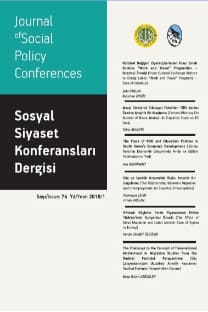Workload, Burnout, and Job Satisfaction Among Call Center Employees
Job Satisfaction, Burnout
___
Bagnara, Sebastiano (2000). Euro-telework: Report on call centres, http://www.telework-mirti.org/reports/sum_ITEN.htm. Bagnara, S., Marti, P. (2001). ‘Human Work in Call Centres: A Challenge for Cognitive Ergonomics‘, Theoretical Issues in Cognitive Science, 2 (3), 223-237. Bain, P., Taylor, P. (2002). ‘Ringing the Changes? Union Recognition and Organisation in Call Centres in the UK Finance Sector’, Industrial Relations Journal, 33(3), 246–61. Barnes, A. (2004). ‘The Organization of Exhaustion‘, M. Barry, P. Brosnan (eds), New Economies: New Industrial Relations içinde, Proceedings of the 18th AIRAANZ Conference, Volume 2 – Refereed Papers. Brown, G. & Gillian M. (2002). ‘Customer Service in UK Call Centres: Organisational Perspectives and Employee Perceptions‘, Journal of Retailing and Consumer Services, 9, 309–316. Çağrı Merkezi Sektör Araştırma Sonuçları (2012), http://cagrimerkezleridernegi.org/index.php/sektorumuz/raporlar/cagri-merkezi-sektor-arastirma-sonuclari/. Datamonitor (1998). Call Centres in Europe, London. Echchakoui, S.& Naji, A. (2013). ‘Job Satisfaction in Call Centers: An Empirical Study in Canada‘, International Journal of Management, 30 (2), 576-592. Fernie, S., Metcalf D. (1997). ‘(Not) Hanging on the Telephone: Payment Systems in the New Sweatshops‘, Centre for Economic Performance, London School of Economics. Feinberg, R. (2004). Cases in Call Center Management : Great Ideas That Work, West Lafayette, IN, USA: Purdue University Press. Grandey, A. A., Dickter, D. N., & Sin, H. P. (2004). ‘The customer is not always right: Customer aggression and emotion regulation of service employees‘, Journal of Organizational Behavior, 25: 397–418. Grebner, S., Norbert K. S., Luca Lo F., Stephan G. (2003). ‘Working Conditions, Well-Being, and Job-Related Attitudes Among Call Centre Agents‘, European Journal of Work And Organizatıonal Psychology, 12 (4), 341-365. Holman, D. (2002). 'Employee Well Being in Call Centres', Human Resource Management Journal, 12(4), 35-51. Houlihan, M. (2002). 'Tensions and Variations in Call Centre Management Strategies', Human Resources Management Journal, 12, (4), 67-86. Houlihan, M. (2001). ‘Managing to Manage? Stories from the Call Centre Flor”, Journal of European Industrial Training, 25(3:4), 208-220. Holland, R., Hunt, J.(1997). ‘The Importance of Staying Technically Competent , Customer Relationship Management, 2 (4), 14–15 . Huebsch, (2009). http://smallbusiness.chron.com/standard-employee-turnover-call-center-industry-36185.html. Kinnie, N., Hutchinson S. & Purcell, J. (2000). ‘Fun and Surveillance: The Paradox of High Commitment Management in Call Centres’, International Journal of Human Resource Management , 11 (5), 967–85. Koole, G., Mandelbaum, A. (2002). ‘Queueing models of call centers: An introduction‘, Annals of Operations Research, 113(1-4), 41–59. Korczynski, M., Shire, K., Frenkel, S., & Tam, M. (2000). ‘Service work in consumer capitalism: Costumers, control and contradiction‘, Work, Employment & Society, 3(4), 669-687. Lewig, K.A., Dollard, M.F. (2003). “Emotional Dissonance, Emotional Exhaustion And Job Satisfaction in Call Centre Workers”, European Journal of Work and Organızatıonal Psychology, 12(4), 366-392. Maslach, C. & Jackson S. (1986). Maslach Burnout Inventory Manual, Palo AIto, California: Consulting Psychologists Press, Inc. Taylor, S. (1998). ‘Emotional Labour and the New Workplace’, P. Thompson ve C. Warhurst (eds) Workplaces of the Future içinde, London: Macmillan. Taylor, P, Mulvey, G, Hyman, J & Bain, P. (2002). 'Work organisation, control and the experience of work in call centres', Work, Employment & Society, 16 (1), 133-150 . Tuten, T.L., Neidermayer, P.E. (2004). 'Performance, satisfaction and turnover in call center: The effects of stress and optimism', Journal of Business Research, 57, 26-34 Visser, W. A. & Rothmann, S. (2008). ‘Exploring antecedents and consequences of burnout in a call centre‘, South African Journal of Industrial Psychology, 34(2), 79-87. Wallace, C.M., Eagleson, G. & Waldersee, R. (2000). 'The sacrificial hr strategy in call centers', International Journal of Service Industry Management, 11(2), 174-84. Zapf, D., Amela I., Myriam B. & Patricia B. (2003). ‘What is Typical For Call Centre Jobs? Job Characteristics, and Service Interactions in Different Call Centres‘, European Journal Of Work And Organızatıonal Psychology, 12 (4), 311-340. Zeytinoglu, I.U., Yilmaz, G., Keser, A., Inelmen, K., Uygur, D., & Ozsoy, A. (2013). ‘Job satisfaction, flexible employment and job security among Turkish service sector workers’, Economic and Industrial Democracy, 34(1): 120-141.- ISSN: 1304-0103
- Yayın Aralığı: 2
- Başlangıç: 1948
- Yayıncı: İstanbul Üniversitesi Yayınevi
Belediyeler ve Çevre Hizmetleri Üzerine Analitik Bir Bakış: Türkiye Örneği
Sosyal Dışlanmanın Anlaşılması: Muğlâklık ve Çok Boyutluluk
Türkiye’de KOBİ’lerin Nitelikli İşgücü İhtiyacı: İşveren – İşgören – Devlet Ekseninde Bir İnceleme
Sinem YILDIRIMALP, Emel İSLAMOĞLU, Bora YENİHAN
Yerel Sosyal Politika Bağlamında “İş’te Engel Yok Projesi”
Türkiye’de Kırdan Kente Göç: Diyarbakır Üzerine Bir Alan Araştırması
Workload, Burnout, and Job Satisfaction Among Call Center Employees
Çağrı Merkezi Çalışanlarının İşyükü, Tükenmişlik ve İş Tatmini Düzeyleri
